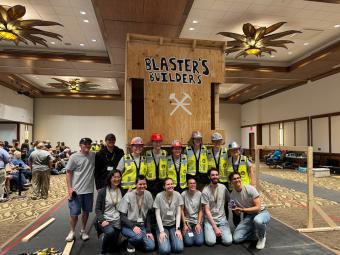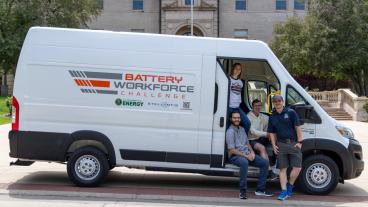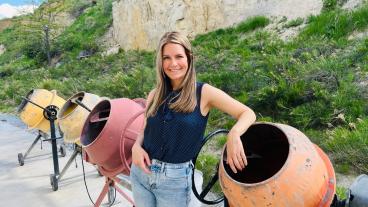Mines students win first place at ASCE Timber-Strong Design Build Competition
Capstone Design team spent year designing 2-story wood building – that they had to assemble on site in less than 90 minutes
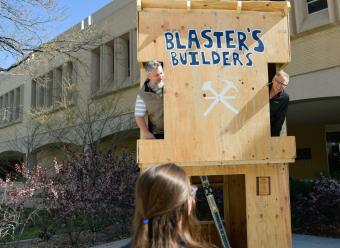
Campus community members check out the Mines team's winning building during Capstone Design Showcase at the end of the spring semester. At the Timber-Strong Design Build Competition, it took the team 54 minutes - out of a maximum of 90 minutes - to assemble the structure.
Civil engineering students at Colorado School of Mines have long had the opportunity to put their construction skills to the test against universities across North America and beyond.
The American Society of Civil Engineers hosts annual competitions for student engineers to cast seaworthy canoes out of concrete and erect scale-model bridges out of steel.
But what about wood – not only the most popular construction material for homes in the U.S. but also fully renewable when harvested from sustainably managed forests?
A new pilot competition sponsored by ASCE, American Wood Council, Simpson Strong-Tie Company and APA – The Engineered Wood Association hopes to fill that gap, and a team of Capstone Design students from Mines competed for the first time this year – and won.
Mines took first place in the Timber-Strong Design Build Competition at the ASCE Rocky Mountain Student Symposium, hosted this spring at the University of Wyoming.
Their challenge? Spend the year designing an artistically creative two-story wood light-framed building that is sustainable, aesthetically pleasing and structurally durable – and then assemble it on site in less than 90 minutes as industry judges look on.
“We got to see it go from a sketch on notebook paper to the real thing,” said Lindsey Nenne, one of the team’s construction leaders, who graduated in May with her bachelor’s degree in civil engineering.
“It was a really good mix of hands-on experience and practical calculations you would be doing in the future if you want to be a structural engineer, especially with wood.”
As with other ASCE student competitions, the team’s light-framed wood building had to meet specific requirements: the building had to be 6 feet wide by 6 feet long by 12 feet tall, with a one-foot roof overhang and 4-foot cantilever, and use Simpson Strong-Tie connectors. Each wall was required to have a window, the second story had to be accessible via an opening, and the structure had to meet certain load, seismic and wind requirements.
Before they could put hammer to nail, the teams also had to submit Building Information Modeling (BIM) documents - which one of the team members had learned how to do during an earlier internship.
“Building also took us longer than we thought – we're not professional carpenters by any means,” Nenne said. “We definitely had a few days in Senior Design where all we did was just practice using a nail gun, practice cutting wood.”
Supporting the team were faculty advisors Hongyan Liu, teaching associate professor of civil and environmental engineering, and Shiling Pei, associate professor of civil and environmental engineering, as well as David Sparks, a local structural engineer with the Felton Group in Denver.
Professor Liu first learned about the wood competition from her involvement in the ASCE Wood Education Committee, introducing the competition to ASCE Region 7 and to Mines as an option for Capstone Design.
Fellow construction lead Annie Osmun considered doing Steel Bridge for her Capstone project, but she changed her mind after checking out a visiting exhibit from Think Wood on the Mines campus.
“I really knew nothing about timber design or mass timber design, but seeing the movement towards that and using more sustainable resources was pretty interesting,” said Osmun, who also graduated in May with her B.S. in civil engineering. “I didn't know that timber could be more sustainable than steel or concrete or safer or better in any way.”
At the regional competition, each team had a 20-by-20-foot space in which to stage and build their structures; nothing – or no one – could extend beyond that space. Up to six team members could help build, but even with pre-fabricating all of the panels in advance, there was still a lot of work – and nails – to put in during the 90-minute build time.
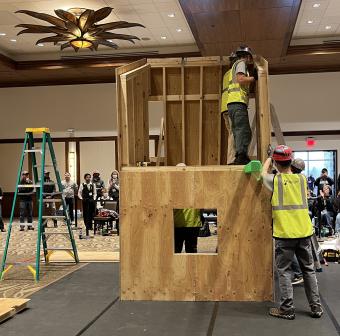
“I wish we would have counted and seen how many nails we put in – it was a lot,” Nenne said.
Rounding out the Mines team was Allison Bean, Rebecca Fox, Belle Goetz, Ben Idler, Logan Koenig, Emerson Lewan, Giovanni Ramirez, Hannah Rhude, Benji Rizzi and Alex Osmun.
Both Nenne and Osmun will be back at Mines in the fall to complete their master’s degrees in civil engineering with an emphasis on structural engineering. The lessons learned through Timber Strong will stick with them well into the future, they agreed.
“Now when I go into the engineering field and maybe go work for a structural engineering firm, in the back of my mind, I'm going to be thinking more about constructability and how are they actually going to build this in the field?” Nenne said.
“I know I want to go in a structural direction with my career. I've had two structural engineering internships. But that has given me only experience in modeling and not at all in constructing,” Osmun said. “I really enjoyed the whole construction process.”
Both also hope to see future Capstone Design teams continue to compete in – and win – Timber Strong.
“Garrett Erickson, our Capstone Design faculty advisor, jokes that next year they're gonna have hammer practice every week,” Nenne said.
